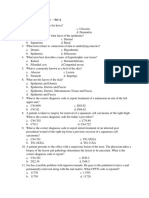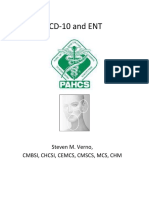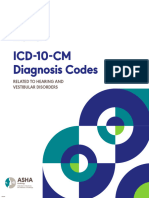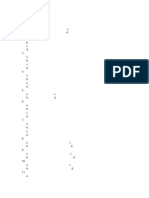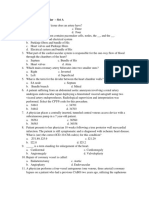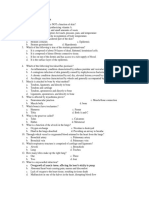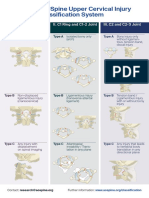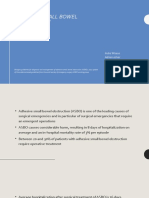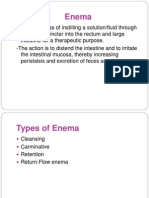0 ratings0% found this document useful (0 votes)
900 viewsChapter 03 Intro Icd 10 CM
Chapter 03 Intro Icd 10 CM
Uploaded by
Bernard Paul GuintoCopyright:
© All Rights Reserved
Available Formats
Download as DOCX, PDF, TXT or read online from Scribd
Chapter 03 Intro Icd 10 CM
Chapter 03 Intro Icd 10 CM
Uploaded by
Bernard Paul Guinto0 ratings0% found this document useful (0 votes)
900 views3 pagesOriginal Title
Chapter 03 intro icd 10 cm.docx
Copyright
© © All Rights Reserved
Available Formats
DOCX, PDF, TXT or read online from Scribd
Share this document
Did you find this document useful?
Is this content inappropriate?
Copyright:
© All Rights Reserved
Available Formats
Download as DOCX, PDF, TXT or read online from Scribd
Download as docx, pdf, or txt
0 ratings0% found this document useful (0 votes)
900 views3 pagesChapter 03 Intro Icd 10 CM
Chapter 03 Intro Icd 10 CM
Uploaded by
Bernard Paul GuintoCopyright:
© All Rights Reserved
Available Formats
Download as DOCX, PDF, TXT or read online from Scribd
Download as docx, pdf, or txt
You are on page 1of 3
At a glance
Powered by AI
Some key takeaways from the passages are that NEC and NOS are commonly used abbreviations in ICD-10-CM, Z codes are assigned when the reason for care is not due to disease or injury, and ICD-10-CM stands for International Classification of Diseases, 10th Revision, Clinical Modification.
NEC and NOS are commonly used abbreviations in ICD-10-CM that stand for 'Not Elsewhere Classified' and 'Not Otherwise Specified' respectively.
A Z code (Z00-Z99) would be assigned as this type of code is used when the provider documents the reason for a patient seeking healthcare that is not an injury or disease.
Chapter 03 : Introduction to ICD 10 CM – Set A
1. NEC and NOS are ___ used in the ICD-10-CM codebook.
a. Abbreviations c. Essential modifiers
b. Eponyms d. Qualifiers
2. Who are the parties responsible for providing the ICD-10-CM guidelines?
a. AAPC and AMA c. NCHS and CMS
b. AMA and CMS d. WHO and CMS
3. What type of code is assigned when the provider documents reason for a patient seeking
health care that is not an injury or disease?
a. External cause code (V00-Y99) c. Non- specific code
b. ICD-10-PCS code d. Z code (Z00-Z99)
4. In the ICD-10-CM Alphabetic Index what is the code it next to the main term called?
a. Category Code c. Default Code
b. Subcategory Code d. Unspecified Code
5. What does ICD- 10-CM stand for?
a. International Code Diagnosis-10, Coding Medical
b. International Class Diagnosis 10th Book, Clinical Medicine
c. Infections Classified Diseases 10th Revision, Clinical Modification
d. International Classification of Diseases, 10th Revision, Clinical Modification
6. What section of the ICD-10-CM guidelines contains instructions on how to code for a
patient receiving diagnostic services only in an outpatient setting?
a. Section I c. Section III
b. Section II d. Section IV
7. What is an example of an eponym?
a. Neuropathy c. Salphingo-oophoritis
b. Paget’s disease d. Xanthoma
8. The term malignant, benign, in situ and uncertain behavior are all terms used when
coding what?
a. Lumps c. Seeds
b. Neoplasms d. Skin rashes
9. What is the meaning of provider in the ICD - 10 - CM guidelines?
a. The hospital c. Insurance company
b. The physician d. The patient
10. What month does the new ICD - 10 - CM code book take effect each year?
a. January c. October
b. March d. December
11. According to ICD - 10 - CM guideline I.B.1 use both ___ and ___ when locating and
assigning a diagnosis code.
a. ICD-10-CM Alphabetic Index and Illustrations
b. ICD-10-CM Alphabetic Index and Tabular List
c. ICD-10-CM codebook and Dictionary
d. Tabular List and Index to Procedures
12. Which of the following statements is TRUE in reference to reporting body mass index
(BMI) codes?
a. BMI codes should be reported as primary codes only.
b. BMI codes should be reported as secondary code only.
c. BMI codes should never be reported in ICD-10-CM.
d. BMI codes are only reported with the ICD-10-CM code E66.3 for overweight.
13. The instructions and conventions of the classification take precedence over
a. Documentation
b. Official Coding Guidelines
c. CPT®
d. Nothing. They are only used in the event of no other instruction.
14. The word "and" should be interpreted to mean ____ when it appears in a title.
a. "And" or "or" - patient may have either or both
b. And – patient must have both
c. Instead of
d. Do not use
15. When a patient has a condition that is both acute and chronic and there are separate
entries for both how is it reported?
a. Code only the acute code
b. Code both sequencing the chronic first
c. Code both sequencing the acute first
d. Code only the chronic code
16. A 6-year-old patient is seen in the office for acute otitis media coded as H66.90. This is
an example of ___ code.
a. Category c. NEC
b. Etiology/manifestation code d. NOS
17. The Diagnosis "Caudal Cervical Inflammatory Spondylopathy" is assigned ICD-10-CM
code M46.82 and is an example of what ICD-10-CM coding convention?
a. Etiology/manifestation code c. NOS
b. NEC d. Unspecified
18. According to the Tabular List in the ICD-10-CM codebook, category code H80,
Otosclerosis includes what other disorder?
a. Otopathy c. Otospongiosis
b. Otorrhea d. Tinnitus
19. Which diagnosis code(s) below reports pain in the left and right ears?
a. H92.01, H92.02 c. H92.03
b. H92.09 d. H93.8X3
20. Refer to the Tabular List and identify the code that contains a note indicating not to code
a specific diagnosis and that it should be coded elsewhere
a. A18.01 c. K31.84
b. N94.2 d. S04.0-
21. Refer to the ICD - 10 - CM Alphabetic Index. Identify the main term below that has an
instructional note indicating another main term may need to be referenced providing an
additional index entry to report the diagnostic code.
a. Appendicitis c. Symptoms
b. Diabetes d. Fibrosarcoma
22. In the ICD - 10 - CM Alphabetic Index next to Hypertension what do the terms in
parentheses indicate?
a. Hypertension cannot be coded unless one of those words is documented with
hypertension in the diagnosis.
b. Hypertension needs two codes assigned.
c. Supplementary words that can be present or absent with the diagnosis hypertension
and does not affect the code to which it is assigned.
d. Look at another main term to find that type of hypertension.
23. What is the sequencing order when coding a sequela (late effect)?
a. The cause of the late effect is coded first and the residual condition is coded second.
b. The symptom is coded first followed by the residual condition and the late effect
code.
c. The cause of the late effect is coded first; the residual condition is coded second
followed by the symptoms.
d. The residual condition is coded first, and the code(s) for the cause of the late effect
are coded as secondary.
24. Which diagnosis code(s) should be reported for chronic gonococcal salpingitis?
a. N70.11, A54.24 c. N70.91, A54.24
b. N70.11 d. A54.24
25. Which diagnosis below would be considered a combination code?
a. E06.0 c. K80.00
b. I07.0 d. R78.0
You might also like
- Medical Coding 1 - ExamDocument4 pagesMedical Coding 1 - ExamAnthony Martinez80% (5)
- Mock13 (F)Document22 pagesMock13 (F)Hasna AyishaNo ratings yet
- Chapter 04: ICD-10-CM Chapters 1-11: Multiple ChoiceDocument41 pagesChapter 04: ICD-10-CM Chapters 1-11: Multiple ChoiceJJK100% (1)
- Icd CodingDocument58 pagesIcd CodingagnaveenanNo ratings yet
- CMA Skill Practice! Practice Test Questions for the Certified Medical Assistant TestFrom EverandCMA Skill Practice! Practice Test Questions for the Certified Medical Assistant TestNo ratings yet
- Chapter 08 MusculoskeletalDocument5 pagesChapter 08 MusculoskeletalBernard Paul GuintoNo ratings yet
- Chapter 07 IntegumentaryDocument4 pagesChapter 07 IntegumentaryBernard Paul Guinto67% (3)
- HypertensionDocument13 pagesHypertensionkennedy1434450% (4)
- Health Grade 7 4q - Module 1Document15 pagesHealth Grade 7 4q - Module 1Mary Candice Cosico100% (2)
- Medical Coding ICD-10-PCS: a QuickStudy Laminated Reference GuideFrom EverandMedical Coding ICD-10-PCS: a QuickStudy Laminated Reference GuideNo ratings yet
- Medical Coding and Billing - The Comprehensive GuideFrom EverandMedical Coding and Billing - The Comprehensive GuideRating: 4 out of 5 stars4/5 (1)
- Medical Coding ICD-10-CM: a QuickStudy Laminated Reference GuideFrom EverandMedical Coding ICD-10-CM: a QuickStudy Laminated Reference GuideNo ratings yet
- Certified Professional Coder (CPC): Passbooks Study GuideFrom EverandCertified Professional Coder (CPC): Passbooks Study GuideRating: 5 out of 5 stars5/5 (1)
- Code from Home: Launch Your Home-Based Medical Billing ServiceFrom EverandCode from Home: Launch Your Home-Based Medical Billing ServiceRating: 5 out of 5 stars5/5 (1)
- Cracking the Code: A quick reference guide to interpreting patient medical notesFrom EverandCracking the Code: A quick reference guide to interpreting patient medical notesNo ratings yet
- Newman's Billing and Coding Technicians Study GuideFrom EverandNewman's Billing and Coding Technicians Study GuideRating: 4.5 out of 5 stars4.5/5 (2)
- How to Open & Operate a Financially Successful Medical Billing Service With Companion CD-ROMFrom EverandHow to Open & Operate a Financially Successful Medical Billing Service With Companion CD-ROMRating: 1 out of 5 stars1/5 (1)
- Textbook of Urgent Care Management: Chapter 42, Evaluation and Management of Coding and DocumentationFrom EverandTextbook of Urgent Care Management: Chapter 42, Evaluation and Management of Coding and DocumentationNo ratings yet
- Medical Billing & Coding Demystified, 2nd EditionFrom EverandMedical Billing & Coding Demystified, 2nd EditionRating: 2.5 out of 5 stars2.5/5 (2)
- ICD QuestionsDocument10 pagesICD QuestionsShagoofaNo ratings yet
- Untitled DocumentDocument6 pagesUntitled Documentrobymuiruri42No ratings yet
- Chapter 05: ICD 10 CM 12-21 - Set ADocument3 pagesChapter 05: ICD 10 CM 12-21 - Set ABernard Paul Guinto0% (1)
- Chapter 05 Icd 10 CM 12-21Document3 pagesChapter 05 Icd 10 CM 12-21Bernard Paul GuintoNo ratings yet
- Chapter 06 Intro To CPT, HCPCS, and ModifiersDocument3 pagesChapter 06 Intro To CPT, HCPCS, and ModifiersBernard Paul GuintoNo ratings yet
- Mock 7Document17 pagesMock 7aaqilf19No ratings yet
- XYZDocument6 pagesXYZchaturvedimilan222No ratings yet
- 2016 MedicalBillingTraining CPB Ch4 OnlineDocument14 pages2016 MedicalBillingTraining CPB Ch4 Onlinejackdorson11211990No ratings yet
- CPC BozDocument31 pagesCPC BozJamesNo ratings yet
- AAPC 2012 Midterm and AnswersDocument18 pagesAAPC 2012 Midterm and AnswersKuro100% (2)
- Medical TerminologyDocument33 pagesMedical TerminologyJJKNo ratings yet
- Quiz 3 PDFDocument4 pagesQuiz 3 PDFanaebelia08No ratings yet
- ICD IntroDocument13 pagesICD IntroSwapna Sampathi RaoNo ratings yet
- Test Bank For Lets Code It 1st Edition by SafianDocument8 pagesTest Bank For Lets Code It 1st Edition by SafianRonald Sturgeon100% (42)
- ICD 10 ManualDocument42 pagesICD 10 ManualLokesh ChowdaryNo ratings yet
- Payment Methodology - QuestionsDocument4 pagesPayment Methodology - QuestionsAnonymous MtKJkerbpUNo ratings yet
- ICD 10 Codes AudiologyDocument57 pagesICD 10 Codes AudiologyEdi AhsaniNo ratings yet
- B. General Coding Guidelines: 1. Locating A Code in The ICD-10-CMDocument4 pagesB. General Coding Guidelines: 1. Locating A Code in The ICD-10-CMMaria Nadia MihalikNo ratings yet
- Guide pdf1710603141Document3 pagesGuide pdf1710603141mjmartinmt66No ratings yet
- Ahima CCSDocument17 pagesAhima CCSpolemonirameshNo ratings yet
- Icd 10 FinalDocument7 pagesIcd 10 Finalanto_prapNo ratings yet
- Mock 3A - 230819 - 110446Document28 pagesMock 3A - 230819 - 110446fanshadvnNo ratings yet
- Complete Download of Test Bank for Let’s Code It 1st Edition By Safian Full Chapters in PDF DOCXDocument42 pagesComplete Download of Test Bank for Let’s Code It 1st Edition By Safian Full Chapters in PDF DOCXtonimaoctor100% (1)
- NABH Questionnair Week2Document3 pagesNABH Questionnair Week2RichaNo ratings yet
- Icd 10 Codes SLPDocument79 pagesIcd 10 Codes SLPvviraa100% (2)
- Medical Coding MCQsDocument22 pagesMedical Coding MCQsHanadiNo ratings yet
- NABH Questionnair Week2Document3 pagesNABH Questionnair Week2Richa0% (1)
- Icd 10 CMDocument13 pagesIcd 10 CMannmariyajohny0102No ratings yet
- ICD-10 and ENT: Steven M. Verno, Cmbsi, Chcsi, Cemcs, CMSCS, MCS, CHMDocument23 pagesICD-10 and ENT: Steven M. Verno, Cmbsi, Chcsi, Cemcs, CMSCS, MCS, CHMArthur PendragonNo ratings yet
- NABH QuestionnairDocument3 pagesNABH QuestionnairRicha100% (4)
- Basic Coding ProjectDocument2 pagesBasic Coding ProjectNeida Caro-BooneNo ratings yet
- Diagnosticos ASHA AudioDocument65 pagesDiagnosticos ASHA AudiocyntialambisNo ratings yet
- Full Download of Test Bank For Let's Code It 1st Edition by Safian in PDF DOCX FormatDocument33 pagesFull Download of Test Bank For Let's Code It 1st Edition by Safian in PDF DOCX Formatjoticaravine100% (1)
- April 2018 Question 1 C: View RationaleDocument6 pagesApril 2018 Question 1 C: View RationaleJohannah DianeNo ratings yet
- 2024 Chapter 27Document4 pages2024 Chapter 27Erica EvansNo ratings yet
- Get Test Bank For Understanding Health Insurance 13th Edition by Green Free All Chapters AvailableDocument31 pagesGet Test Bank For Understanding Health Insurance 13th Edition by Green Free All Chapters AvailableauesqetusaNo ratings yet
- Icd 9 VS 10Document4 pagesIcd 9 VS 10kiran5451No ratings yet
- Icd10 Improving Diagnosis Coding 0Document3 pagesIcd10 Improving Diagnosis Coding 0maria.neves9No ratings yet
- ICD-10-CM Official Guidelines For Coding and Reporting: Italics Are Used To Indicate Revisions To Heading ChangesDocument32 pagesICD-10-CM Official Guidelines For Coding and Reporting: Italics Are Used To Indicate Revisions To Heading ChangesBernard Paul GuintoNo ratings yet
- Chapter: - Set ADocument3 pagesChapter: - Set ABernard Paul GuintoNo ratings yet
- CPT Modifier 19Document15 pagesCPT Modifier 19Aneez MalikNo ratings yet
- Chapter 16 Anesthesia Set BDocument4 pagesChapter 16 Anesthesia Set BBernard Paul Guinto50% (2)
- Cats Is An Upcoming 2019 BritishDocument1 pageCats Is An Upcoming 2019 BritishBernard Paul GuintoNo ratings yet
- The Oxford Companion To Chess Quiet Positional Play: Op-Level ObjectivesDocument1 pageThe Oxford Companion To Chess Quiet Positional Play: Op-Level ObjectivesBernard Paul GuintoNo ratings yet
- Chapter 20: Medicine - Set ADocument4 pagesChapter 20: Medicine - Set ABernard Paul GuintoNo ratings yet
- Chapter 19 Evaluation and Management ServicesDocument6 pagesChapter 19 Evaluation and Management ServicesBernard Paul GuintoNo ratings yet
- Medical CodingDocument5 pagesMedical CodingBernard Paul GuintoNo ratings yet
- Chapter 20: Medicine - Set ADocument4 pagesChapter 20: Medicine - Set ABernard Paul GuintoNo ratings yet
- Chapter 18 Path and Lab Set BDocument4 pagesChapter 18 Path and Lab Set BBernard Paul Guinto0% (1)
- Chapter 05 Icd 10 CM 12-21Document3 pagesChapter 05 Icd 10 CM 12-21Bernard Paul GuintoNo ratings yet
- Chapter 09 RespiratoryDocument3 pagesChapter 09 RespiratoryBernard Paul Guinto0% (2)
- Chapter 20 Medicine Set BDocument5 pagesChapter 20 Medicine Set BBernard Paul Guinto100% (2)
- Chapter 17: Radiology - Set BDocument3 pagesChapter 17: Radiology - Set BBernard Paul GuintoNo ratings yet
- Chapter 10 CardiovascularDocument3 pagesChapter 10 CardiovascularBernard Paul Guinto100% (1)
- Chapter 05: ICD 10 CM 12-21 - Set ADocument3 pagesChapter 05: ICD 10 CM 12-21 - Set ABernard Paul Guinto0% (1)
- Chapter 02 Medical Terminology Set ADocument3 pagesChapter 02 Medical Terminology Set ABernard Paul Guinto100% (1)
- Chapter 06 Intro To CPT, HCPCS, and ModifiersDocument3 pagesChapter 06 Intro To CPT, HCPCS, and ModifiersBernard Paul GuintoNo ratings yet
- 2018 Chapter 2 Anatomy QuizDocument3 pages2018 Chapter 2 Anatomy QuizBernard Paul Guinto100% (1)
- AOS Injury Classification Pocket Card UPPERCERVICALDocument2 pagesAOS Injury Classification Pocket Card UPPERCERVICALDonald Moncada GarayNo ratings yet
- 1886 - NEET PG Sunday Question Paper FinalDocument25 pages1886 - NEET PG Sunday Question Paper FinalNurul Haque0% (1)
- Referat Stroke - VideoDocument37 pagesReferat Stroke - VideoFirmansah SaputraNo ratings yet
- DotsDocument2 pagesDotsJml JuNo ratings yet
- Epps Motion For Compassionate ReleaseDocument10 pagesEpps Motion For Compassionate Releasethe kingfishNo ratings yet
- Adhesive Small Bowel Obstruction-2Document16 pagesAdhesive Small Bowel Obstruction-2Indra WisesaNo ratings yet
- Extra Edge Info: SurgeryDocument3 pagesExtra Edge Info: SurgeryskNo ratings yet
- Nosocomial Infection. BPTDocument44 pagesNosocomial Infection. BPTAanchal GuptaNo ratings yet
- Acute Abdomen 2013Document42 pagesAcute Abdomen 2013pelukisbintangNo ratings yet
- Breast and LymphaticDocument4 pagesBreast and LymphaticJan Vincent BallesterosNo ratings yet
- The Use of Cold Plasma in The Treatment of CancerDocument7 pagesThe Use of Cold Plasma in The Treatment of CancerCentral Asian StudiesNo ratings yet
- Proposed Activities and Advanced Work Plan - Docx2Document4 pagesProposed Activities and Advanced Work Plan - Docx2Joseph Nawen SindiongNo ratings yet
- Autism Thesis IdeasDocument8 pagesAutism Thesis Ideasgjfs5mtv100% (1)
- Long Term Complications of Hemodialysis 12 18Document8 pagesLong Term Complications of Hemodialysis 12 18MutiaraHandayaniNo ratings yet
- Appendicitis: Signs and SymptomsDocument7 pagesAppendicitis: Signs and SymptomsRoro AliNo ratings yet
- ICD-10-AM - ACHI - ACS - Summary of Updates Tenth Edition 311016Document7 pagesICD-10-AM - ACHI - ACS - Summary of Updates Tenth Edition 311016drrskhanNo ratings yet
- Recommended Parameters For IPL C White SkinDocument4 pagesRecommended Parameters For IPL C White Skin77yr72cdh6No ratings yet
- Pediatric Palliative Care Referral CriteriaDocument7 pagesPediatric Palliative Care Referral Criteriaapi-197110397No ratings yet
- Handouts Onco Prof. RojasDocument5 pagesHandouts Onco Prof. RojasChallen CulturaNo ratings yet
- Appendix - List of Critical Illnesses: 45 Critical Illness (1 Year and Above)Document1 pageAppendix - List of Critical Illnesses: 45 Critical Illness (1 Year and Above)hassan poiNo ratings yet
- Emergency Department Bronchiolitis Care Guideline: Inclusion CriteriaDocument3 pagesEmergency Department Bronchiolitis Care Guideline: Inclusion CriteriaPatricia KoikyNo ratings yet
- Gastroduodenal PerforationDocument4 pagesGastroduodenal PerforationMaresp21No ratings yet
- Pediatric Nursing: Narayan Swami College of NursingDocument10 pagesPediatric Nursing: Narayan Swami College of NursingAnkit KotnalaNo ratings yet
- What Is A Communicable DiseaseDocument3 pagesWhat Is A Communicable DiseaseChrisel D. SamaniegoNo ratings yet
- DLobash KHT Adv MMT M2 LuLi 1UPDocument46 pagesDLobash KHT Adv MMT M2 LuLi 1UPFrancisco Javier Martín FernándezNo ratings yet
- CheatsheetsDocument2 pagesCheatsheetsprosie392No ratings yet
- Rare Diseases ISSDocument175 pagesRare Diseases ISSGiorgio CortassaNo ratings yet
- Enema PowepointDocument17 pagesEnema PowepointShane Lim Garcia0% (1)







